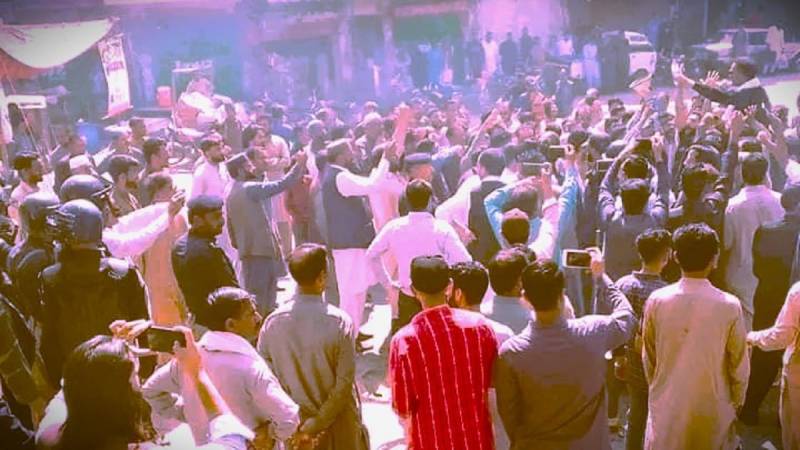
On 12th May, people from every nook and corner of Azad Jammu and Kashmir (AJK) will gather in Muzaffarabad to set the stage for a showdown against the ‘all parties Azad government’ and the status quo. This comes as the next – and possibly last – phase of the non-cooperation movement that started a year ago against rising flour prices and electricity bills.
Largely nonviolent, the movement has now entered an ugly phase where speculations are rife that the federal forces, such as the Frontier and Punjab constabularies, recently sanctioned by Islamabad to be deployed in AJK to protect the Chinese personnel and CPEC projects, will be used against the protesters: the same has happened in Poonch during the armed uprisings of1950 and 1955. Few may be aware that since its inception, AJK continuously fought to retain and further strengthen its quasi-sovereign status. What’s happening today has strong roots in the legacy of this region.
However, the character of the ongoing movement is quite different: it is class consciousness that has gripped the masses and added fuel to the fire of discontent that has been simmering since 5th August 2019. It is reminiscent of Mao’s ‘Investigation of the peasant movement in Wuhan province’, and perhaps an inquiry of that scale is required to fully deconstruct this movement, but alas, few insights are available to understand and grapple with.
The set of demands put forth by the JKJAAC – the Jammu Kashmir Joint Awami Action Committee – range from reducing power tariffs and flour prices to taking full ownership of the hydel projects active in the region. But what remains at the heart of it all is the public’s anger over the loot and plunder of the region’s resources and the enabling character of AJK’s political leadership towards this exploitation. The leadership is mostly dynastic – more than two-thirds are in their 70s and 80s – and almost all with luxurious bungalows in gated communities of Rawalpindi and Islamabad seem incapable of understanding the generational change, class dynamics and unbearable burden of unemployment which has taken the alienation and anger to a whole new level.
Oblivious to the ground situation, the standalone and self-righteous former caretaker prime minister, Anwaar ul Haq Kakar, who doesn’t belong to any political party yet ‘righteously’ bagged 90% of the assembly votes, believes the uprising in the region is orchestrated by New Delhi and has urged troops to stop people from reaching Muzaffarabad, where the JKJAAC has announced an indefinite sit-in. Such attempts will have an adverse impact on the peaceful nature of this grassroots movement, which has, in the past, demonstrated the capability and intentions required to achieve political rights by offering huge sacrifices.
Class consciousness has gripped the Kashmiri masses, adding fuel to the fire of discontent that has been simmering since 5 August 2019
It is, however, interesting as to how a region like AJK developed a common insight and intervention around its class identity and nonviolence courtesy of grassroots political workers who, over the last ten years, have deliberately moved away from city centres to their villages and towns to sensitise and mobilise people around issues of infrastructure development and rising costs of living. The JKJAAC is an amalgam of dozens of such village, ward, constituency, tehsil and district-level units that give birth to a new generation of leaders, mostly young and hailing from the working classes, with no interests tied to the status quo. It is one major reason why the established dynastic council of traditional leaders finds it difficult to engage the JKJAAC, albeit for a few who are giving their clandestine support to the movement.
Given its disputed nature, any such movement in Azad Kashmir is likely to raise a few eyebrows in both New Delhi and Islamabad, which may put a covert restraining order on the movement and its reach. Both countries may also view it as an opportunity to nudge the movement in their desired direction as well. However, if the intentions are right, this movement in its essence carries the broader contours of a political solution on Kashmir, but only for the eyes that seek and ears that attend.
A few years ago, while working with an international peacebuilding organisation, I had the opportunity to undertake an extensive mapping of the political opinions in AJK and Gilgit-Baltistan to outline the themes for an inclusive intra-regional dialogue amongst the divided parts of the erstwhile Jammu and Kashmir state. It turned out that people across the divide were determined to regain and maintain collective ownership of their natural resources and sources of production and almost attained a consensus of sorts on building a healthy, happy and sustainable life in their territories while keeping a fair share of sovereignty. It is the same sentiment that is on display in Azad Kashmir and Gilgit-Baltistan, which also provides a blueprint for the future course of action vis-à-vis the political future of these regions.
Contrary to what apologists of neoliberalism are preaching in Pakistan, the movement in AJK is seeking to occupy and thus empower the region’s government, and not the private sector, by making attempts to replace the old guard and restore the sanctity and prowess of the region’s political legacy and democratic institutions.

